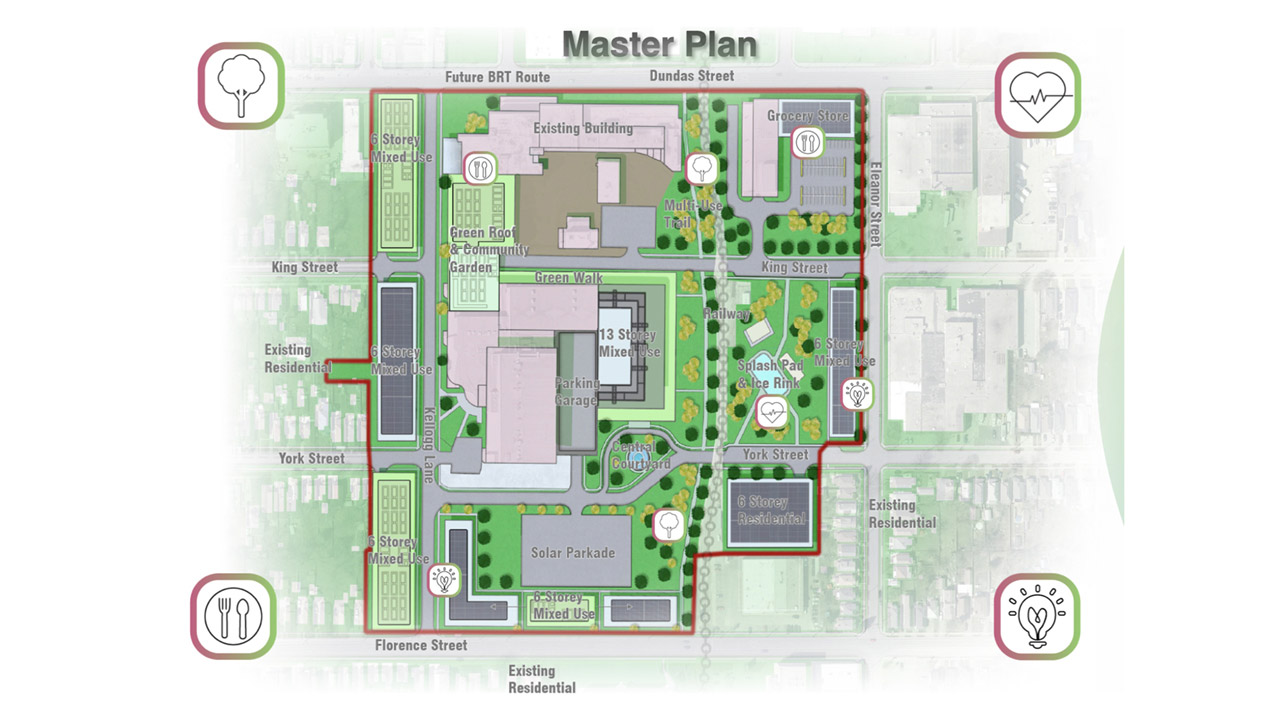Fanshawe students propose a sustainable future for 100 Kellogg Lane
 CREDIT: COURTESY OF KRISTINA PAVLOU
CREDIT: COURTESY OF KRISTINA PAVLOURed Brick Revitalization's final plan for 100 Kellogg Lane.
Fanshawe’s GIS and Urban Planning program has taken part in the 2022 urban design project to bring a more sustainable future to 100 Kellogg Lane. The theme was “Green the City” where six groups of first and second-year students in the program make a design for Kellogg Lane, incorporating various guidelines in a week. The guidelines they had to follow were greening the city (turning pavement into green space), energizing the city (adding solar or wind energy to the site), feeding the city (producing food), and health. For health, they looked at how they can make the space healthier for people’s mental and physical health.
Kristina Pavlou is a first-year in the group who won first place in the design charette. The group was named Red Brick Revitalization and consisted of Pavlou, William Brent House, Braeden Howard, Quinn Keep, Manveer Lail, Kyujin Lee, and Alexander Kanski.
“The theme for this site was inspired by the themes of the 2022 Floriade Expo in the Netherlands,” said Pavlou. “Our plan was to design a site that fulfilled all the themes of Floriade while still preserving the heritage of the area. Our vision was to promote an environmentally sustainable mixed-use hub that would be the heart of Old East Village.”
Through their design, they wanted to enhance urban resilience through improved food supplies, promote active lifestyles and clean living, and integrate features that promote smart energy.
“We also acknowledged that there’s a major housing need. So we also wanted to add additional residential units to the site.”
Kellogg Lane is a very industrial area, but the students made that work with their designs.
“We wanted to incorporate more of those green open spaces, increase the tree canopy of the area, we incorporated green roofs on both the existing and new buildings that we included, and we planted trees along paths with concrete base benches. So imagine a tree and then at the bottom there’s a circle around the base. That acts as a bench so when people are walking, they have somewhere to sit and can enjoy the shade of the tree.”
They also incorporated a splash pad and ice rink combination, where you can cool off in the summer and go for a skate in the winter. It was inspired by one similar in Newmarket, where Pavlou is from.
Professor William Pol met with the groups every day to assist in any way needed since it is a big project to complete in such a short amount of time.
“I was astounded at the ability of our students in the charette to take these ideas and themes and come up with designs in one week,” says Pol. “It’s truly amazing. I’m always nervous starting the charette because you don’t know what the result will be. But the master plan, the visualizations, their ability to present their ideas to the judges was excellent.”
Pol said that the final decision of who came out in first place was very difficult and the scores were very close.
“Faculty do not do the judging. It’s all up to the outside professionals and it was very hard for them to figure out who was the winner. That always makes me very proud that our students do the quality of work that they do. I think the judges were astounded by the quality of work that students could do in a week.”
This short timeline is put in place purposefully because in the real world, sometimes they will have to work under tight, stressful deadlines. It is preparing them for the workforce once they graduate.
Now, students have the opportunity to submit their final designs to the TD Environmental Design competition if they choose. It’s about greening the city, following suit with Fanshawe’s charette. This competition involves all of the colleges and universities across Canada.
















